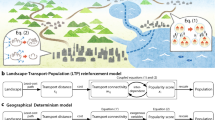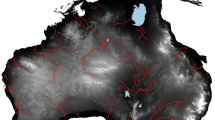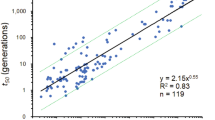Abstract
There are many unanswered questions about the evolution of the ancient ‘Silk Roads’ across Asia. This is especially the case in their mountainous stretches, where harsh terrain is seen as an impediment to travel. Considering the ecology and mobility of inner Asian mountain pastoralists, we use ‘flow accumulation’ modelling to calculate the annual routes of nomadic societies (from 750 m to 4,000 m elevation). Aggregating 500 iterations of the model reveals a high-resolution flow network that simulates how centuries of seasonal nomadic herding could shape discrete routes of connectivity across the mountains of Asia. We then compare the locations of known high-elevation Silk Road sites with the geography of these optimized herding flows, and find a significant correspondence in mountainous regions. Thus, we argue that highland Silk Road networks (from 750 m to 4,000 m) emerged slowly in relation to long-established mobility patterns of nomadic herders in the mountains of inner Asia.
This is a preview of subscription content, access via your institution
Access options
Access Nature and 54 other Nature Portfolio journals
Get Nature+, our best-value online-access subscription
$29.99 / 30 days
cancel any time
Subscribe to this journal
Receive 51 print issues and online access
$199.00 per year
only $3.90 per issue
Buy this article
- Purchase on Springer Link
- Instant access to full article PDF
Prices may be subject to local taxes which are calculated during checkout




Similar content being viewed by others
References
de la Vaissière, É. Sogdian Traders: A History. (Brill, 2005)
Hansen, V. The Silk Road: A New History. (Oxford Univ. Press, 2012)
Foltz, R. C. Religions of the Silk Road. (St. Martin’s Griffin, 1999)
Christian, D. Silk Roads or Steppe Roads? The Silk Roads in World History. J. World Hist. 11, 1–26 (2000)
Whitfield, S. Life Along the Silk Road. (Univ. California Press, 1999)
Frachetti, M. in Reconfiguring the Silk Road: New Research on East–West Exchange in Antiquity (eds Mair, V. H. & Hickman, J. ) 41–54 (University of Pennsylvania Museum of Archaeology and Anthropology, 2014)
Williams, T. D. The Silk Roads: an ICOMOS thematic study. (ICOMOS, 2014)
Ciolek, T. M. Old World Trade Routes (OWTRAD) Project. http://www.ciolek.com/owtrad.html (2012)
Barnard, H. & Wendrich, W. in Cotsen Advanced Seminar Series Vol. 4, 603 (Regents of the University of California, Los Angeles, 2008)
Harris, D. R., Gosden, C. & Charles, M. P. Jeitun: Recent Excavations at an Early Neolithic Site in Southern Turkmenistan. Proc. Prehist. Soc. 62, 423–442 (1996)
Stevens, C. J. et al. Between China and South Asia: a Middle Asian corridor of crop dispersal and agricultural innovation in the Bronze Age. The Holocene 26, 1541–1555 (2016)
Miller, N. F., Spengler, R. N. & Frachetti, M. Millet cultivation across Eurasia: Origins, spread, and the influence of seasonal climate. The Holocene 26, 1566–1575 (2016)
Spengler, R. N. Agriculture in the central Asian Bronze Age. J. World Prehist. 28, 215–253 (2015)
Khazanov, A. M. in Shifts and Drifts in Nomad-Sedentary Relations (eds Leder, S. & Streck, B. ) 163–178 (Dr. Ludwig Reichert Verlag, 2005)
Frachetti, M. D. Multiregional emergence of mobile pastoralism and nonuniform institutional complexity across Eurasia. Curr. Anthropol. 53, 2–38 (2012)
Doumani, P. N. et al. Burial ritual, agriculture, and craft production among Bronze Age pastoralists at Tasbas (Kazakhstan). Archaeological Research in Asia 1–2, 17–32 (2015)
Frachetti, M. D. & Maksudov, F. A. The landscape of ancient mobile pastoralism in the highlands of Uzbekistan, 2000 b.c.–a.d. 1400. J. Field Archaeol. 39, 195–212 (2014)
Outram, A. K. et al. Patterns of pastoralism in later Bronze Age Kazakhstan: new evidence from faunal and lipid residue analyses. J. Archaeol. Sci. 39, 2424–2435 (2012)
Robinson, S. Pastoralism in the Gorno-Badakhshan Region of Tajikistan. Nomad. People. 9, 199–206 (2005)
Kuz’mina, E. E. in Prehistoric Steppe Adaptation and the Horse (eds Levine, M., Renfrew, C. & Boyle, K. ) 203–232 (McDonald Institute for Archaeological Research, 2003)
Possehl, G. L. Pastoral nomadism in the Indus civilization: an hypothesis. South Asian Archaeology 1, 537–551 (1979)
Potts, D. T. Nomadism in Iran: From Antiquity to the Modern Era. (Oxford Univ. Press, 2014)
Di Cosmo, N. Ancient Xinjiang between central Asia and China: the nomadic factor. Anthropol. Archeol. Eurasia 34, 87–101 (1996)
Frank, A. G. The centrality of central Asia. Stud. Hist. 8, 43–97 (1992)
Miller, B. K. Xiongnu ‘kings’ and the political order of the steppe empire. J. Econ. Soc. Hist. Orient 57, 1–43 (2014)
Rogers, J. D. Inner Asian states and empires: theories and synthesis. J. Archaeol. Res. 20, 205–256 (2012)
Beckwith, C. I. Empires of the Silk Road: A History of Central Eurasia from the Bronze Age to the Present. (Princeton Univ. Press, 2009)
Khazanov, A. M. Nomads and the Outside World. 2nd edn (Univ. Wisconsin Press, 1994)
Salzman, P. C. Pastoral nomads: some general observations based on research in Iran. J. Anthropol. Res. 58, 245–264 (2002)
Sobolev, L. N. & Pel’t, N. N. Kormovye resursy Kazakhstana [Fodder Resources of Kazakhstan] (Izd-vo AN SSSR, 1960)
Frachetti, M. D. in Digital Archaeology: Bridging Method and Theory (eds Evans, T. L. & Daly, P. T. ) 128–147 (Routledge, 2006)
Jia, P. W., Betts, A. & Wu, X. New evidence for Bronze Age agricultural settlements in the Zhunge’er (Junggar) Basin, China. J. Field Archaeol. 36, 269–280 (2011)
Liu, X., Reid, R. E., Lightfoot, E., Matuzeviciute, G. M. & Jones, M. K. Radical change and dietary conservatism: mixing model estimates of human diets along the Inner Asia and China’s mountain corridors. The Holocene 26, 1556–1565 (2016)
Barfield, T. in Nomads in the Sedentary World Curzon-IIAS Asian Studies Series (eds Khazanov, A. M. & Wink, A. ) Ch. 10, 234–250 (Curzon, 2001)
Stride, S., Rondelli, B. & Mantellini, S. Canals versus horses: political power in the oasis of Samarkand. World Archaeol. 41, 73–87 (2009)
Angourakis, A. et al. Land use patterns in central Asia. Step 1: the musical chairs model. J. Archaeol. Method Theory 21, 405–425 (2014)
Frachetti, M. D. Pastoralist Landscapes and Social Interaction in Bronze Age Eurasia. (Univ. California Press, 2008)
Seland, E. H. & Bintley, M. Writ in water, lines in sand: ancient trade routes, models and comparative evidence. Cogent Arts & Humanities 2, (2015)
Yang, J. Transportation, boarding, lodging, and trade along the early Silk Road: a preliminary study of the Xuanquan manuscripts. J. Am. Orient. Soc. 135, 421–432 (2015)
Spengler, R. et al. Early agriculture and crop transmission among Bronze Age mobile pastoralists of central Eurasia. Proc. R. Soc. Lond. B 281, 20133382 (2014)
Mei, J. Qijia and Seima-Turbino: the question of early contacts between northwest China and the Eurasian steppe. Museum of Far Eastern Antiquities bulletin 31–54, http://cat.inist.fr/?aModele=afficheN&cpsidt=17748473 (2003)
Honeychurch, W. Alternative complexities: the archaeology of pastoral nomadic states. J. Archaeol. Res. 22, 277–326 (2014)
Rogers, J. D. The contingencies of state formation in eastern Inner Asia. Asian Perspect. 46, 249–274 (2007)
Brosseder, U. & Miller, B. K. Xiongnu Archaeology – Multidisciplinary Perspectives of the First Steppe Empire in Inner Asia in Bonn Contributions to Asian Archaeology 5 (ed. Bemmann, J. ) (Rheinische Friedrich-Wilhelms-Universität Bonn, Bonn, 2011)
Chase-Dunn, C. et al. Middlemen and marcher states in central Asia and east/west empire synchrony. Soc. Evol. Hist. 9, 52–79 (2010)
Whitfield, S. Life Along the Silk Road. (Univ. California Press, 2015)
Jenkerson, C. B., Maiersperger, T. & Schmidt, G. eMODIS: A user-friendly data source. Open-file Rep. (U.S. Geol. Surv.) 2010–1055 (2010)
Frachetti, M. D. Bronze Age Pastoral Landscapes of Eurasia and the Nature of Social Interaction in the Mountain Steppe Zone of Eastern Kazakhstan. PhD thesis, University of Pennsylvania, http://repository.upenn.edu/dissertations/AAI3138010/ (2004)
Acknowledgements
Funding for research at the SAIE laboratory was provided by Washington University in St. Louis (M.D.F.). C. Copp and M. Webb provided assistance with modelling and coding in the SAIE laboratory and GIS laboratory of Washington University in St. Louis. C. Chady assisted in copy editing. An early version of the pastoralist participation model was presented at the Advanced Seminar ‘New Geospatial Approaches in Anthropology’ at the School for Advanced Research, March 6–10, 2016. P. Daly, R. Pinhasi, G. Larson and D. Meltzer provided commentary on drafts of this article.
Author information
Authors and Affiliations
Contributions
M.D.F. conceptualized the study, designed, and executed the spatial model, and wrote the manuscript with editing and approval from C.E.S., T.W. and C.M.T. C.E.S. carried out spatial modelling and script coding in ArcGIS and Python. C.M.T. carried out statistical modelling and analysis of the results. T.W. provided the Silk Road site database and contributed to analysis and interpretation of the results. M.D.F. carried out spatial and statistical analysis and interpretation of the results with contributions and input from C.E.S., C.M.T. and T.W.
Corresponding author
Ethics declarations
Competing interests
The authors declare no competing financial interests.
Additional information
Reviewer Information Nature thanks D. Rogers and the other anonymous reviewer(s) for their contribution to the peer review of this work.
Extended data figures and tables
Extended Data Figure 1 Flowchart of the PastPart model workflow yielding a summed aggregate of 500 runs of flow accumulation within the modelled elevation ROI (750–4,000 m).
Inputs: (1) model source directory; (2) NDVI data; (3–6) DEM images; (7–10) model parameter files: settlement_class.txt, sheep_class.txt, pasture_class.txt, vegetation_class.txt. Outputs: (1) processing geodatabase; (2) results geodatabase; (3) NDVI converted to GRID format; (4–7) DEM images converted to GRID format; (8) study area DEM; (9) study area NDVI; (10) probablity surface; (11) cost surface; (12) weight raster; (13) 5,000 random spatially balanced points; (14) cost distance raster; (15) flow direction raster; (16) flow accumulation raster. Processes: (1) create geodatabases; (2) load files to processing geodatabase; (3) mosaic DEM files and clip images to study area; (4) create model inputs: (a) classify study area DEM using settlement_class.txt to create probability surface, (b) classify NDVI using vegetation_class.txt create vegetation priority raster, (c) classify DEM using sheep_class.txt to create highland flow weight raster; (5) generate spatially balanced random settlements (n = 5,000); (6) calculate cost distance; (7) calculate flow direction; (8) calculate flow accumulation; (9) sum flow accumulation rasters. Variables: (1) number of iterations; (2) current iteration value; (3) number of output points. Unused data: (1) output backlink raster; (2) output drop raster.
Extended Data Figure 2 Distribution of Silk Road sites versus randomized points across the modelled elevation ROI.
Top, distribution of known Silk Road Sites (n = 258) in relation to the modelled elevation ROI (750–4,000 m, in grey). Bottom, distribution of a single run of randomized test points (n = 258) generated in relation to the modelled elevation ROI (in grey). 200 runs of random test point cohorts were calculated in the modelled elevation ROI.
Extended Data Figure 3 Detailed view of the seasonal highland–lowland division of the elevation ROI (750–4,000 m).
Highland ‘summer’ zones (green) are defined from 1,500 m to 4,000 m above sea level, and ‘winter’ campsite zones (blue) are defined from 600 m to 1,500 m above sea level. Prominent Silk Road cities are mapped for geographic reference.
Extended Data Figure 4 Detailed view of one run of spatially balanced random points distributed throughout in the winter campsite elevation.
In total, 5,000 points were generated (for each of the 500 runs the PastPart model) in the winter campsite settlement elevation range (from 600 m to 1,500 m) across the entire study zone (map inset). Each iteration of sites recalculates (along with the reclassified vegetative weight raster) the ‘cost distance’ map across the modelled elevation ROI (750–4,000 m).
Extended Data Figure 5 Input data classes for the pastoralist participation model.
Top, detail of reclassified vegetative weight raster (veg_priority) overlaid with one run of randomized foothill points (n = 5,000) simulating winter campsites. Bottom, detail of the cost distance raster (CD_x) calculated using 5,000 randomized ‘winter settlement’ points and the vegetative weight raster. Each of the 500 iterations of new points changes the geographic distribution of ‘low cost’ travel between weighted pasture zones (750 m to 4,000 m) and the lower elevations—effectively causing variations in the flow accumulations from pastures to hypothetical settlements in the foothills with each iteration.
Extended Data Figure 6 Comparative geography of proposed Silk Road corridors.
Calculated using least-cost (ease-of-travel) algorithms (black and blue lines) to connect known archaeological/historical sites7 and the simulated herding flow pathways from 500 aggregate runs of the PastPart model (yellow and red ‘flow’ network). Source Data is available in the online version of this paper. Notable differences between modelled ‘ease-of-travel’ corridors and ecologically derived flow accumulation pathways are visible in the inset detail maps. a, PastPart flow accumulation pathways illustrate highland Silk Road routes between Narat (61) and Karkara (18) and alternative highland passes to the east of the Turugart Pass (31) towards Kashgar (133). b, A potentially undocumented corridor of the Silk Road into the Tibetan Plateau to the south of Dunhuang (406) (China). c, A number of alternative networks of connectivity across the western Himalaya and Pamir Mountains, for example diverse routes from Kashgar (133) to Tashkurgan (345).
Supplementary information
Supplementary Information
This file contains the Supplementary Discussion, Supplementary References, Supplementary Table 1, a link to the executable ArcPython script to run the PastPart model in ArcGIS and the statistical report providing comprehensive data and illustration of the range of statistical analysis carried out for this study. (PDF 341 kb)
Rights and permissions
About this article
Cite this article
Frachetti, M., Smith, C., Traub, C. et al. Nomadic ecology shaped the highland geography of Asia’s Silk Roads. Nature 543, 193–198 (2017). https://doi.org/10.1038/nature21696
Received:
Accepted:
Published:
Issue Date:
DOI: https://doi.org/10.1038/nature21696
This article is cited by
-
Geospatial modelling of farmer–herder interactions maps cultural geography of Bronze and Iron Age Tibet, 3600–2200 BP
Scientific Reports (2024)
-
Different trajectories of livelihood transformations in response to the trans-Eurasian exchange in agricultural, pastoral, and agro-pastoral regions of north China during the late Neolithic and Bronze Age
Journal of Geographical Sciences (2024)
-
Archaeology of the Silk Road: Challenges of Scale and Storytelling
Journal of Archaeological Research (2024)
-
New evidence for regional pastoral practice and social complexity in the Eastern Tianshan Mountains in the first millennium BCE
Scientific Reports (2023)
-
ecolo-zip: A global, rich and granular characterization of biogeophysical ecology for 1.5 million postal codes
Scientific Data (2023)
Comments
By submitting a comment you agree to abide by our Terms and Community Guidelines. If you find something abusive or that does not comply with our terms or guidelines please flag it as inappropriate.



